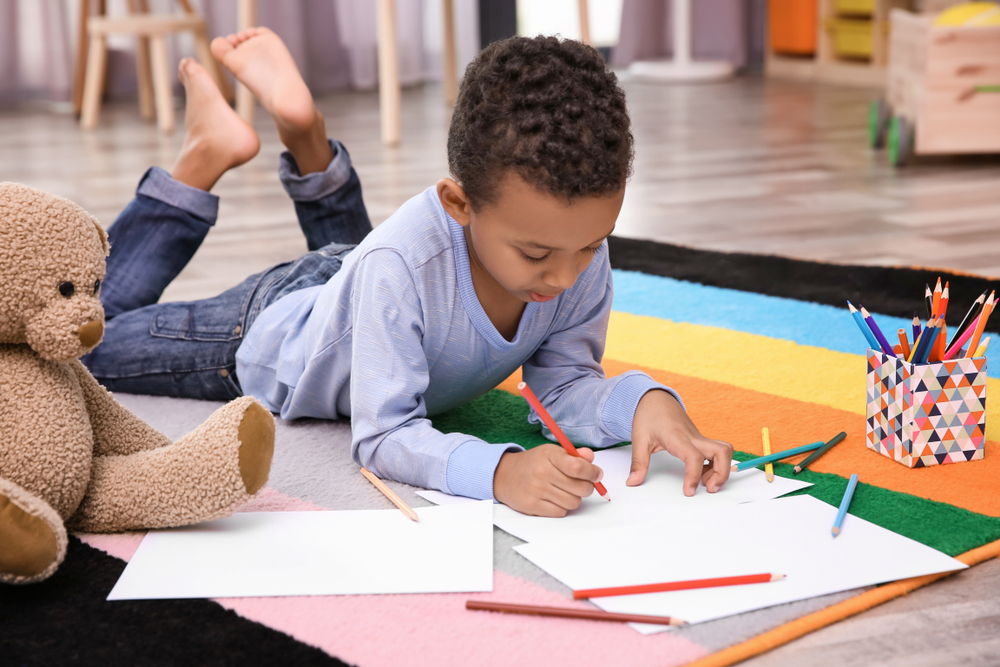
On a rainy day, a snowy day or even during a long break like during the winter holidays or summer, parents might be looking for new activities to do with their children. Maybe they’ve visited all the local museums or explored all the parks. Perhaps it’s just so miserable that indoor activities are a must.
Parents also might look for ways to engage their child with more educational activities. Ready to get creative? Here’s how to improve your child reading by making wordless books at home.
What do parents and children need to make wordless books? Gather these supplies:
- Paper (construction paper or just plain white printer paper)
- A stapler (for easy book binding)
- Crayons or markers
- Glitter
- Stickers
- Stencils
What are Wordless Books?
Parents might be unfamiliar with the term ‘wordless book.’ What is a wordless book and how does it help reading?
A wordless book is a picture book without words. Yes, the book is only different pictures. These books encourage children to tell their own stories; they must think of plots, name characters and even figure out how the book will end.
Wordless books don’t help children read by decoding, but they do encourage creativity. They also help children understand that books have beginnings, middles and endings, too. Reading Rockets explains that wordless books also help with vocabulary, listening skills and even comprehension.
These books are more than just pictures or illustrations, they are doorways to creativity. Wordless books also are incredibly easy to make. There are no right or wrong creations. When a child creates their own wordless book, they may be writing or creating a story in their head as they are drawing pictures.

How to Make a Wordless Book
Writing or creating a wordless book is fun and it’s also really easy. The hardest part of the project might be deciding on the length of the book.
Provide children with a stack of blank pieces of paper. Tell them that they are going to create a book with only pictures. They can draw whatever they want. However, after they create their book, they will use the book to tell the story using only the pictures that they draw on the pages.
Make sure children understand that they don’t have to write any words on the page. Remember, wordless books are wordless!
Children can create their illustrations using whatever they want or whatever items parents have on hand. Parents can gather markers, crayons, stickers, glitter pens or glitter glue, or stencils.
When the story is ‘written,’ parents can staple all the pages together to create the book. Parents should encourage children to make a cover for their book, though. Let them illustrate the cover and write a title for their book. They also shouldn’t forget their author by-line.
50 Fun Ideas for Wordless Books
The ideas for creating wordless books are really endless. Children can create all kinds of colorful illustrations to tell stories of all genres. Parents can create their own wordless books to read with children, too.
When families are stuck inside and aren’t sure what type of books to create, here are fifty different themes to inspire literary or illustrative creativity. The themes will all be basic, because the rest is up to the creator.
- A dreary rainy day stuck indoors
- It’s a happy snow day!
- Secrets inside an old house
- Finding buried treasure on a beach
- A visit to the local zoo
- The first day at a new school
- The first day of summer vacation
- An unspooky Halloween
- Adopting a new pet
- Visiting a new country (children can even make up their own country)
- Getting new eyeglasses
- Visiting the pumpkin patch
- A fairytale adventure
- An outer space exploration
- Walking on the moon
- Creatures under the sea
- The most embarrassing day
- The best day ever
- Home sick from school
- Meeting a new friend
- The grossest thing I ever ate
- If I could fly
- If I was the President
- Going on a camping trip
- Going to the dentist
- Suddenly I have superpowers
- The greatest adventure
- If kids were in charge
- Ice cream and cake for dinner
- The day everything was backwards
- The coolest hero
- Stuck on a desert island
- A mystery delivery
- A day at Grandma and Grandpa’s house
- An undiscovered planet
- A story for sleeping
- Exploring a new park
- A fun road trip
- A day on the farm
- Finding a message in a bottle
- The carnival comes to town
- A snowy holiday
- The day it rained chocolate
- I’m in the Olympics
- If cars could fly
- If the toys really could talk
- My hamster saved the day
- I’m invisible for a day!
- A trip on a train
- A hot air balloon adventure
There are so many different ideas and themes for children to create their own wordless stories. Parents don’t have to insist that children pick from this list of ideas, although the themes could help spark a child’s imagination.
Even when a child sticks to a theme—like ‘If cars could fly’—the story will change every time the child and the parent reads the books. The illustrations might show certain scenes or depictions, but children can create new adventures from the same illustrations.
Characters could go on different adventures in the flying car. Something new could happen that didn’t in early tales. Pictures are worth more than 1,000 words, because with wordless books there are endless story opportunities.
Have fun creating and reading all the wordless stories and adventures!

Use a Reading App to Listen to Stories and Provide Extra Enrichment
Wordless books help children create their own stories, and they also can help with comprehension, listening skills and vocabulary, too. For children that need extra reading enrichment for reading fluency or comprehension, parents also can use apps like Readability to help them with their reading journey.
Readability is an app-based program, and it’s designed to be used on a tablet or a smartphone. Children read stories aloud, and Readability includes a built-in AI tutor that’s programmed to recognize their voice. When a child has trouble decoding a word, the tutor will offer help.
The tutor also asks questions at the end of each story to gauge comprehension. If a child answers a question incorrectly, the tutor will show the child a passage from the book that helps them answer the question. The tutor also reads this passage aloud.
Readability includes a Storytime feature that lets children listen to all their favorite Readability stories and follow along. Hearing the story can help children pick up on emotions of characters and perhaps help them identify pieces of information that they missed while reading.
Children can use Readability from preschool through fifth grade. Parents can follow their child’s reading progress through a portal called the Program Dashboard. This shows all the child’s reading data, including fluency (words read per minute), comprehension, time spent using Readability, the number of books read and the child’s reading level.
Interested in using Readability to further guide a child’s reading journey? Sign up for a free seven-day trial today!

 Español
Español